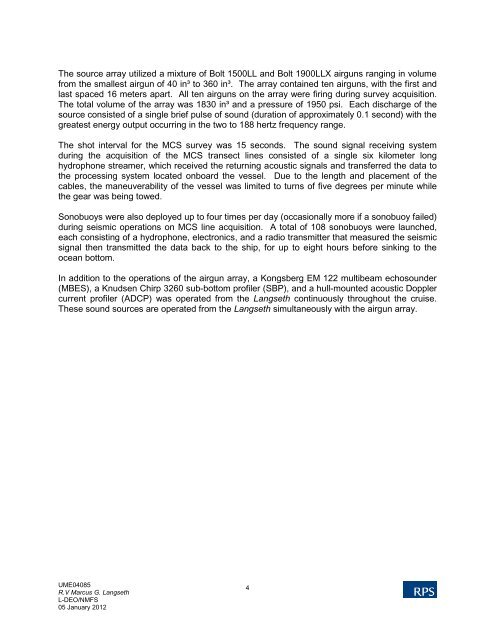90-day Monitoring Report - National Marine Fisheries Service - NOAA
90-day Monitoring Report - National Marine Fisheries Service - NOAA
90-day Monitoring Report - National Marine Fisheries Service - NOAA
You also want an ePaper? Increase the reach of your titles
YUMPU automatically turns print PDFs into web optimized ePapers that Google loves.
The source array utilized a mixture of Bolt 1500LL and Bolt 1<strong>90</strong>0LLX airguns ranging in volume<br />
from the smallest airgun of 40 in³ to 360 in³. The array contained ten airguns, with the first and<br />
last spaced 16 meters apart. All ten airguns on the array were firing during survey acquisition.<br />
The total volume of the array was 1830 in³ and a pressure of 1950 psi. Each discharge of the<br />
source consisted of a single brief pulse of sound (duration of approximately 0.1 second) with the<br />
greatest energy output occurring in the two to 188 hertz frequency range.<br />
The shot interval for the MCS survey was 15 seconds. The sound signal receiving system<br />
during the acquisition of the MCS transect lines consisted of a single six kilometer long<br />
hydrophone streamer, which received the returning acoustic signals and transferred the data to<br />
the processing system located onboard the vessel. Due to the length and placement of the<br />
cables, the maneuverability of the vessel was limited to turns of five degrees per minute while<br />
the gear was being towed.<br />
Sonobuoys were also deployed up to four times per <strong>day</strong> (occasionally more if a sonobuoy failed)<br />
during seismic operations on MCS line acquisition. A total of 108 sonobuoys were launched,<br />
each consisting of a hydrophone, electronics, and a radio transmitter that measured the seismic<br />
signal then transmitted the data back to the ship, for up to eight hours before sinking to the<br />
ocean bottom.<br />
In addition to the operations of the airgun array, a Kongsberg EM 122 multibeam echosounder<br />
(MBES), a Knudsen Chirp 3260 sub-bottom profiler (SBP), and a hull-mounted acoustic Doppler<br />
current profiler (ADCP) was operated from the Langseth continuously throughout the cruise.<br />
These sound sources are operated from the Langseth simultaneously with the airgun array.<br />
UME04085<br />
R.V Marcus G. Langseth<br />
L-DEO/NMFS<br />
05 January 2012<br />
4
















